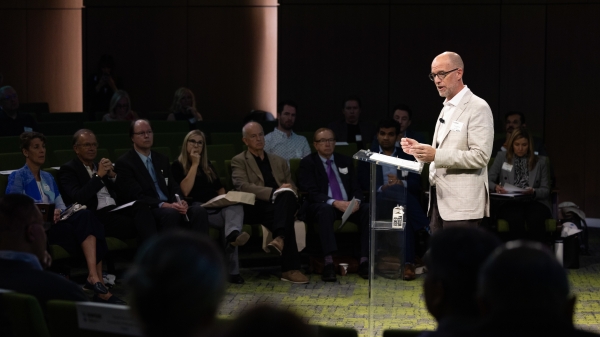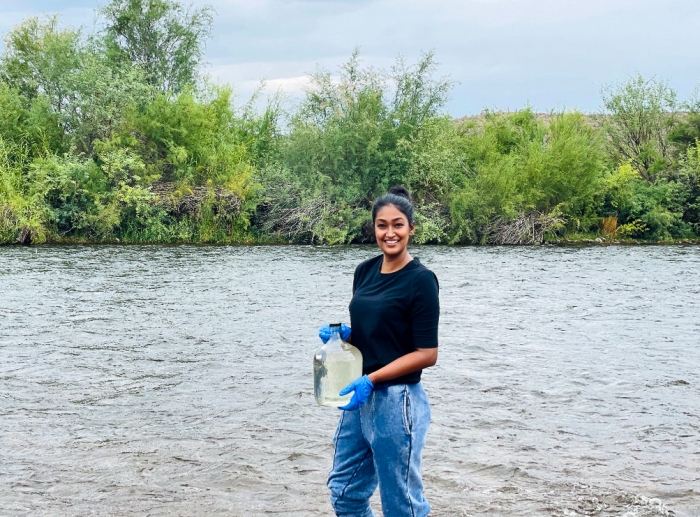New ASU research shows swimwear is a surprising source of microplastics

The Salt River, Tonto National Forest. Courtesy photo
It’s not just bottles and trash polluting our waters.
When Arizona families cool off in backyard pools or float down the Salt River, few consider the environmental impact. But a new study from ASU’s School of Molecular Sciences shows that these recreational activities are contributing to the rise of microplastic pollution, without you even realizing it.
The study that was recently published in the journal Water Emerging Contaminants & Nanoplastics discovered a significant spike in microplastic fiber concentrations in the Salt River following human activity. On a single day in July 2023, microplastic levels in the Salt River increased eightfold, with most fibers traced back to plastics in swimwear.
“The research shows that all of our activities have an effect,” said Pierre Herckes, a chemistry professor in ASU’s School of Molecular Sciences and corresponding author of the paper. “Normally, we don't think of our swimsuit as being plastic, but it is a source of synthetic (plastic) fibers. Of course, we’re not saying that everybody should go swim naked or anything like that, but it’s important to know that our activities are releasing plastics.”
The work highlights that, while microplastics are often associated with mismanaged waste, our everyday activities like swimming or tubing also contribute to environmental pollution.
What tiny fibers can teach us
Microplastics, tiny plastic debris smaller than the size of a pencil eraser, have been extensively studied in marine environments in recent years, but their occurrence in freshwater sources and recreational waters have been less explored.
In 2023, Kanchana Chandrakanthan, a then ASU chemistry graduate student, led the field work to examine how human recreation impacts microplastic levels in water.
“We wanted to see what would be the variation of microplastics during the day before tubing and after tubing in July, and also ... afterwards in October when there's no tubing,” said Chandrakanthan, who is now an assistant teaching professor in the School of Molecular Sciences. “In the past, we've studied the air and the soil, but we've never done microplastic water samples at the Salt (River) before.”
The ASU study focused on two main locations: the Salt River, where tubing and swimming are popular, and a series of apartment community pools in nearby Tempe.
Researchers found that during recreational hours, microplastic concentrations in the Salt River increased by up to eight times, compared with before recreational hours, to reach levels similar to those in the swimming pools. Subsequent analysis of the water samples revealed a prevalence of polyester and polyamide fibers, indicating that synthetic fabrics, such as swimwear, were a substantial source of microplastics in the environment.
Going with the flow ... of research
While the researchers are not encouraging people to give up swimming or tubing anytime soon, they suggest that industry improvements in swimwear materials, using natural or biodegradable materials or increasing the durability of the textiles, would help mitigate some of the pollution.
The study sheds light on how microplastics enter the environment, and although they’ve been found in water sources worldwide, their long-term impact on human health and ecosystems is still not fully understood.
“We're just beginning to determine what concentrations might be dangerous,” Herckes added. “But one thing is clear: They're everywhere."
Matthew Fraser, a professor in ASU’s School of Sustainable Engineering and the Built Environment within Ira A. Fulton Schools of Engineering, is also a co-author of this study.
More Environment and sustainability

Researcher works on changing people's mindsets to fight climate change
Meaningful action to heal the climate requires a complete shift in the way people think and perceive each other, according to an expert on social transformation who spoke at Arizona State University…

NOAA, ASU offer workshop to bridge ocean exploration, education
Oceans are vital to sustaining life on Earth, as they produce over half of the oxygen we breathe and play a crucial role in regulating the planet's climate. They also support a diverse array of…

A united front for sustainability and the economy
When four leaders of esteemed learning institutions and the mayor of Phoenix gather in one location at the same time, it’s a tip-off that something big is going down.When they’re joined by visionary…
